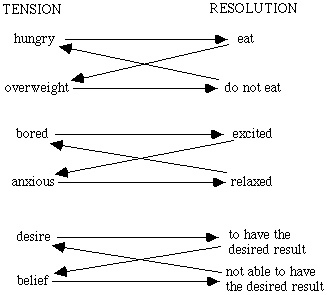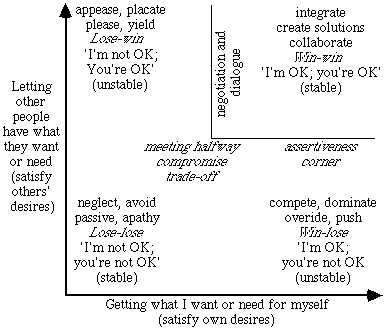The Structure of Problems
by Peter Shepherd
When you want to change yourself or help others to change, you need to gather information, the noticeable parts of a problem, the symptoms one is uncomfortable with. This is the present state.
There will also be a desired state: an outcome that is the goal of change. There will be the resources that will help to achieve this outcome and also side effects to reaching it, for oneself and others. There will of course be the barriers and difficulties. But there will also be underlying causes that maintain the problem: what does the person keep having to do that maintains the problem, and why?
The element of conflict is intrinsic to problems and the trick of solving them is to be able to spot the counter element to one's own intention, and thereby. to recognise that one does indeed have a causative contribution to the situation, otherwise it would not be intention versus counter-intention - a problem! The 'solution' to the problem is simply a realisation of the structure of the problem itself. The charge or confusion of the problem will then drop away, and appropriate actions may be taken.
Conflicts are frequently self-imposed, when both the intention or the counter-intention are one's own, but one forgets this obvious fact and swings back and forth between the opposing points of view. Once a tension exists, because of a discrepancy between what is desired and what exists, there is a natural force leading to resolution. But then the other tension-resolution system is restimulated and the force reverses. This structure will lead to oscillation because of the competing tension-resolution systems. You cannot simultaneously achieve both aims because they are conflicting. And you cannot achieve the aims sequentially, since movement towards the resolution of one increases the tension in the other system. There is a shift of dominance from one approach to the other. It's a no-win situation.

For example, if you were hungry you would naturally tend to resolve this tension by eating. However if you were obsessive and became overweight, a new goal would become apparent - the need to lose weight and the necessity of going on a diet. This second need is in conflict with the first and the two cannot be met simultaneously and not for long sequentially either. If you don't eat you become more and more hungry and revert to the old behaviour. The dieter may consider: What is the problem? Too little self-control, emotional complexes, self-destructive tendencies, lack of willpower, the wrong diet plan, an unfulfilled sex life, the economy? In truth it is the structure in play leading to oscillation; that is all it can do.
A similar conflict structure was examined earlier, as paratelic boredom led to involvement, which when it became too exciting, caused a telic anxiety crisis and a retreat to relaxation.
Another very common structural conflict in everyone's life is between a heartfelt desire or need and an incompatible dominant belief or even knowledge that you are not able to fulfil your desire, that it is impossible, that there isn't time, that one is not capable enough or doesn't deserve it.
At first sight it would seem easy to 'solve' this structural conflict by changing the dominant belief to a more positive 'I can have what I want'. However this just sets up a new desire - 'to change my belief' - that is incompatible with the belief itself, so the conflict persists, no matter how sincere you are or how diligently you try to brainwash yourself. The other obvious solution to structural conflict is to give up your desires. But if you attempt to relinquish all desires, this itself becomes your new desire. Also implicit in 'giving up desire' are spiritual goals such as enlightenment or being freed from the 'illusion of reality'. But these goals are still connected with the 'I can't have what I want' tension-resolution system and will therefore fail.
The fact is, structural conflict is not resolvable from within the structure. Mutually exclusive goals cannot both be achieved either simultaneously or sequentially (for any length of time). People often attempt to overcome this with great hope and optimism but this is usually followed by disillusionment. It is inherent that any actions you persuade yourself to take to resolve structural conflict, or to stay within an area of tolerable conflict, may give temporary relief but ultimately they only reinforce the experience of limitation, and entrench the conflict further. It is only by changing the underlying structure (the roots of the desires and beliefs) of your life that you can make any real and lasting change - changes built on top of the structure (to alter or suppress it) will not work because they do not remove the underlying conflict.
As an example, if your car's front wheels were out of balance and pulled slightly to the left, you might develop a compensating strategy of steering to the right in order to move straight ahead. If the car's tendency to pull to the left developed gradually, your compensating mechanism would also develop gradually - you might not even realise this was going on. (Driving another car, your habit would be dangerous, and that may be how the behaviour comes home to you). If a friend observed you driving this way he would be alarmed and suggest, 'Don't steer to the right - let me out!'. Much of the advice people give one another will not work because it is designed to change compensating strategies without any notion of the structures that are causing them.
In the language of organisational management, what do we do, then, when faced with two incompatible requirements, or two parties who want apparently incompatible things? There are only three possibilities:
Domination - one side wins and the other loses. This often leads to the losing side building up its forces so that it can win next time around.
Compromise - each side gives up a part of what it wants for the sake of peace. This is always unsatisfying to some degree and each side may try to get its way in some overt or covert way. This approach tends to reduce integrity.
Integration - both sides get what they really want, and for this to be possible we look for the needs behind the wants. This way, when it can be found is most satisfying, but it needs a counselling approach to reveal the underlying compatibility of the needs of the two sides. Conflicts must be carefully brought out and worked with, rather than being overridden, smoothed out or ignored. The outcome of this is that creative solutions may emerge which nobody had in mind at the beginning of the process, because the underlying structure has been perceived for the first time.

All growth is a matter of differentiation and integration, and the differentiation is just as important as the integration. The first rule for obtaining integration is to put your cards on the table, face the real issue, uncover the conflict, bring the whole thing out into the open. If we do this, and attempt to bring things out into the open so they can be worked on, it is possible to meet people whom one knows are opposed in interest and to confront them as a whole person, unafraid and ready to comunicate empathetically towards mutual understanding.
It is possible to be flexible and human at the same time as standing for no nonsense. It also seems that if we want creative solutions, this is the best way to get them. One needs to get to the truth of what is really wanted, then the energies will flow to achieve that. But what won't work is attempting to resolve conflicts and change beliefs by suppression or force.
Move on to Beliefs.
Return to Transforming the Mind - Contents.